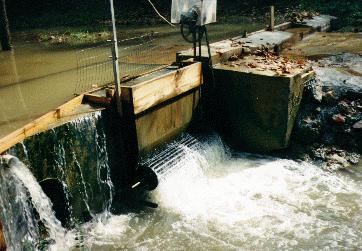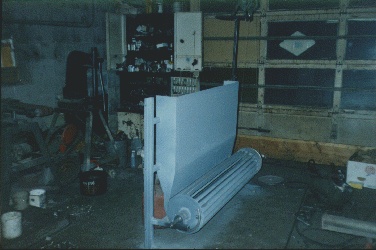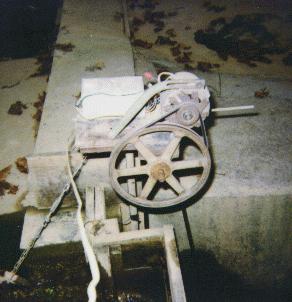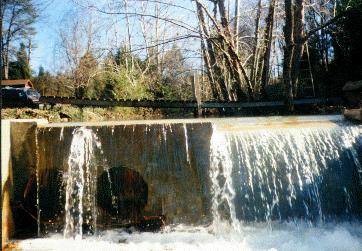
Micro-Hydroelectric System

Click
here to find out more about the complete,
detailed, Hydroelectric Design Manual.
Alternate energy is not cheap. In fact, compared to commercially generated electric power, most forms of alternate energy are very expensive. However, you can't just compare the cost of commercial power to the cost of an alternate energy system and base your decision to install or not to install a system on a payback period of three or four years. There are other reasons to produce your own power besides costs.
Perhaps your property is located no more than a mile from the utility company power lines. If that is the case then alternate energy becomes very attractive. Often a utility company will charge you up to $20,000 per mile to provide power to a remote site! And then you will still have a monthly bill to pay.
How reliable is your commercial power? As I am writing this I have been living "off the grid" for over twelve years and I have only been without electricity twice; about every six years I have to replace the batteries! Power for the color television, computer, radio, ceiling fans, lights, and appliances is never more that a flip of a switch away.
Living without commercially generated electric power gives you a sense of freedom like you have never felt before. You have been dependent all of your life on the utility company. You have suffered at their every whim. Whether your electricity comes from a nuclear power plant, a hydroelectric plant, or a coal fired plant, you are paying for the cost of the nuclear folly through higher utility rates. Alternate energy is "home grown"; energy harvested by you to satisfy your needs. Alternate energy puts you in control of your life and your destiny.
Many people find they have a need for electricity in places beyond the reach of utility lines. They might have a barn a half a mile or more from the house. They might wish to build a house far from utility lines. For example, I have a personal friend who recently purchased the last lot in a series of five. His lot was several thousand feet from the nearest utility line and he was the first of the buyers to decide to build. The local utility company forced him to pay $27,000 to cover the cost of bringing power to his site! For the next five years, he must pay a minimum electric bill of $450 each month, no matter how little power he actually uses! The other owners will not be charged any extra when they are ready for power.
Many land owners look wishfully at the creek that flows through their property. They dream of tapping the power of the water, but they are not blessed with a waterfall or with any way to develop a head of ten to twenty feet. (The head is the vertical drop of the water.) All they have is a high volume creek flowing through relatively flat land. I designed this system to illustrate the feasibility of using an ultra low head hydroelectric system to provide "usable amounts" of electric power. This system is designed to be located in the creek bed using a small dam to provide a minimum head. The prototype micro-hydroelectric system operates on a head of about 2.75 feet!
Most small, hydroelectric systems require a head of at least 10 feet before they will generate an acceptable amount of power. During my research, several experts at Eco-Village told me it was impossible to generate usable amounts of power with less than four feet of head. (Eco-Village was an experiment in alternate energy system design and implementation sponsored The Mother Earth News.) The design of this system allows for operation using a minimum head of twenty inches and a flow rate greater than four cubic feet per second. The head on the prototype micro-hydroelectric system is about 33 inches. The basic turbine is a cross flow design, twelve inches in diameter and 5.5 feet long. Normal operation requires a flow rate of 5.5 cubic feet per second. The turbine rotates at approximately 120 RPM and turns a modified Delco car alternator via a belt drive system.

Actual Generating Capacity

The prototype micro-hydroelectric system is capable of producing about 400 watts of electricity or 9.6 Kilowatt-hours per day. I believe that with additional modifications it will be possible to improve the efficiency of the system so it will be capable of producing approximately 500 watts.

The main part of the dam is located in the creek bed and is less than four feet tall. The dam is about twenty feet long and eighteen inches thick. This part of the dam was poured at one time and required 10 yards of concrete that weighted about 20 tons. Rebar was used throughout the dam. About a year later some additional concrete was required to build a spillway to allow for spring flooding.
The flow of the creek fluctuates greatly. In the late winter through early summer the flow is about 15 cubic feet per second. During late summer and fall the flow decreases to about 4.0 cubic feet per second. This turbine was designed to operate efficiently on a flow of 5.5 cubic feet per second. As water flow decreases, electric power production is reduced to about 100 watts.
The investment in the design and development of this project was approximately $7000. This includes all expenses associated with the construction of the turbine, turbine nozzle, and dam. It does not include my labor hours. However, with the knowledge and insights I have gained a similar installation would require an investment of about $2500 (excluding personal labor).
In order to estimate the payback on this type of project, I have compared estimated construction costs to the costs of providing electricity to a remote site. If my friend had an acceptable creek flowing through his property the payback for him would have been less than six months.
For several years, we used gasoline generators to provide our power. Each generator cost about $500 and had a useful life of about two years. It consumed an average of 1.5 gallons of gasoline each day. The annual operating cost was estimated to be $852. (Assuming gasoline is $1.10 per gallon @ 1.5 gallons per day, that comes to $602 dollars per year. Depreciation is $250 per year.) Assuming a $2500 installation cost, the pay-back is just under three years.
A solar electric system providing equivalent power would require an array of 40, 47 watt panels that would operate an average of five hours per day in our area. This system would have cost in excess of $12,000! The estimated life of solar electric panels is 20 years. If the $12,000 installation cost is prorated over the twenty year life, then the cost becomes $600 per year. At a rate of $600 per year, it would require just over four years to pay for the micro-hydroelectric system.
The annual operating costs for the micro-hydroelectric system are very low. The standard V pulley belts must be replaced every six months, this is approximately $70 per year. Presently, the bearings are replaced each year at a cost of around $60. The brushes and bearings in the alternator are replaced annually for about $20. (I have estimated the alternator operates for the equivalent of almost 400,000 miles per year.) The pulley system is replaced every two years, the estimated annual cost is $25. The total estimated annual operating cost is $175.
The micro-hydroelectric system produces approximately 14 Volts Alternating Current, variable frequency. A modified car Delco car alternator is used. The voltage is increased to 140 volts using a step-up transformer. Conventional battery chargers are used to charge golf cart batteries located at three sites. An A-Frame house (1008 square feet) and the well house are each powered directly by two, six volt batteries, wired to provide twelve volts. Power is also sent to my earth-sheltered home approximately 700 feet away from the micro-hydroelectric system installation. The electrical system of my earth-sheltered home (1920 square feet) operates from the batteries via a Trace 612 inverter. The six, six volt batteries in the earth-sheltered home are wired in a series/parallel method to provide twelve volts to the inverter.
The options for home scale micro-hydroelectric systems are very limited. A few companies will custom design and build a system, assuming you have a high enough head. But their systems are not really designed for the single home site. The price is very high! The Alternate Energy Sourcebook published by the Real Goods Trading Corporation offers two hydroelectric systems. Both of these systems are designed to operate on a minimum head of 20 feet and 100 gallons of water flow per minute. The "standard" output is 400 watts @ 12 Volts Direct Current or 700 watts @ 24 Volts Direct Current. In their book they site the following as a "typical" installation:
Site Conditions:
Head...............................................100 feet
Flow................................................15 gallons per minute
Pipe Length....................................300 feet
Pipe Size.........................................2" PVC
Distance To Battery.........................30 feet
Output............................................100 watts
Construction Costs:
Pipe................................................$100
Turbine...........................................$875
Regulator........................................$340
Batteries.........................................$180
Wire, etc.........................................$50
Total Costs.....................................$1545
I have created a DOS based program (remember DOS?) designed to aid you in the creation of your hydroelectric system. The program will calculate the critical dimensions for the turbine based on the available head and flow rates. You can click here to download the program now!
Quest Enterprises specifically disclaims any warranty, either expressed or implied, concerning the information on these pages. We will have no liability for loss, damage, or injury, resulting from the use of any information found of this, or any other web page we have created.
Quest Enterprises®
5840 Brights Pike
Russellville, TN 37860
Copyright ©1996 - 2010 All Rights Reserved
Hosting and site design by WebQuestHosting.net®
